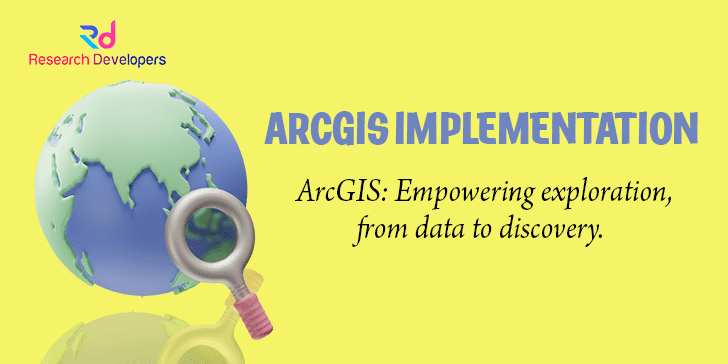ArcGis Mapping & Analysis
Where research begins: Expert guidance on topic selection.

ArcGis Mapping & Analysis
ArcGIS can be used in a variety of ways, depending on how sophisticated your requirements are.
Some users utilize ArcGIS mainly as a mapping as well as analysis tool for one user, typically within the confines of a specific, time-limited project. Project GIS is another term for this widespread application of ArcGIS. ArcGIS is utilized by others in a multiuser system intended to meet the continuous geographic information needs of an organization. Depending on the system’s degree of integration and complexity with an organization’s daily operations, multiuser GIS can be separated into departmental and enterprise GIS.
ArcGIS is introduced in this book within the framework of research GIS since a research is an excellent, self-contained approach to investigate a number of fundamental GIS functions.
An analyst working on a GIS analysis assignment must complete a number of tasks that fall into four main categories.
Creating a GIS database design and analysis plan is the first stage in answering a query like, “How many potential customers are near this store?” or “Where is the best place for a new building?” This entails segmenting the question into logical sections, determining which data layers are required to address each section, and formulating a plan for assembling the responses to all sectional questions into a single comprehensive response.
The next action is to compile the geographic information needed to address the issue into a database. Digitising old maps, acquiring and translating electronic data from many formats and sources, ensuring that each layer are of sufficient standard for the job at hand and could involve adding items to the data to monitor analysis result values and verifying that each layer are in the identical coordinate system and are overlapping appropriately. Project GIS geodatabases are arranged using personal geodatabases and file-based workspaces.
The data analysis process comes next. This typically entails layering many layers, querying features and characteristics to address every question’s logical section, saving the responses to the question’s logical sections, and then obtaining as well as merging the given responses to produce a comprehensive response.
Delivering the study’s findings to individuals who do not utilise GIS or have varying degrees of map-reading knowledge is the last stage in a project-based analysis. Graphs, reports, and maps are all frequently used in tandem to convey the response to the query.
People inside an organization, ranging from a handful in an unitary office to thousands in several branch offices, utilize a multiuser geographic information system (GIS) in a variety of ways to support their daily duties.
Systems created inside a unit department for supporting a department’s critical function are referred to as departmental GIS. For instance, a planning agency may frequently use GIS to alert nearby property owners to planned zoning changes.
Typically, a departmental GIS is run internally, with specialists assigned to various responsibilities. A department may, for instance, employ a GIS analyst, a digitizer, and a system administrator.
Frequently, departmental GIS is tailored to streamline as well as automate processes. A GIS application, for instance, may be used by the planning department to locate the addresses as well as names of parcel owners inside a predetermined layout and then specifically create notice letters.
An organization’s departments are included in an enterprise GIS. The given big networks help an organisation with a variety of tasks, from strategic planning to day-to-day operations. Typically, an enterprise GIS is maintained as a component of the information technology department of the company. An enterprise GIS for a city, for instance, unifies the commercial operations involved in creating and maintaining the city. The planning department, assessor, and engineering department all use the same geodatabase when building a subdivision’s infrastructure.
An enterprise GIS runs on the full network of an organisation. An enterprise GIS is storing data in commercial relational database management systems (RDBMSs) in order to facilitate access for a large number of users.
Multiple users can access and edit GIS data at once when ArcSDE is used. Multiple sePROSats of essential programmes are installed on desktop computers throughout an organisation to fully utilise the possibilities of a networked system. They receive data from servers, which also carry out CPU-intensive operations.
The following lists some benefits and drawbacks of ArcGIS Desktop over competing GIS software programs.
PROS
1. Scalability to add additional functionality
2. Robust framework for geoprocessing
3. lovely possibilities for print and web maps in cartography
4. Complete range of tools for editing and topology
5. ArcGIS Online for web maps and mobile applications
CONS
1. high maintenance and use costs
2. License levels provide fewer resources for fundamental
3. Interoperability falls short in terms of supporting uncommon formats.
4. discontinued in favor of ArcGIS Pro
For the most part, ArcMap is a desktop mapping program that lets users create, examine, edit, and alter maps representing geographic data. It offers resources for carrying out spatial analysis, dealing with and displaying spatial data, and creating excellent cartographic results.
Among ArcMap’s primary functionalities and attributes are the following:
Map Creation: Shapefiles, raster pictures, feature classes, and other geographic data types can all be added to maps by users.
Data Visualization: With a variety of styles, colors, and labels, ArcMap users can represent and display data. It facilitates the depiction of both qualitative and quantitative data.
Spatial Analysis: Tools for performing spatial analyses, including overlay operations, proximity analysis, network analysis, and terrain modeling, are provided by the software.
Geoprocessing: Users can alter and analyze geographic data using a variety of geoprocessing tools included in ArcMap. Tasks like buffer construction, spatial joins, and data translation can be carried out with the help of these technologies.
Cartography: ArcMap provides sophisticated cartographic tools for the design and creation of visually appealing maps fit for a range of uses, such as publication and presentation.
Layout Design: By positioning map components like titles, scale bars, legends, and north arrows, users can design their own map layouts. Making final map outputs for printing or digital sharing is a valuable application of this.
Data modifying: Users can add, edit, and remove features from vector datasets using the tools that ArcMap offers for modifying geographic data.
Integration with Data Sources: Databases, web services, and other GIS programs are just a few of the data sources that ArcMap can connect to and supports.
Management of Spatial Databases: ArcMap’s ability to manage and query spatial databases makes it possible for users to effectively store, arrange, and retrieve spatial data.
Other Services
- PHD & POST DOC Admission counselling
- Topic Section
- Review Paper Writing
- Systematic Literature Review (SLR)
- Research Paper Writing
- Synopsis Writing/Pre thesis writing
- Thesis Writing
- Data Analysis
- Questionnaire Preparation
- Developing Research Framework
- Methodology Development
- MATLAB Implementation
- Matlab Simulation
- Python Implementation
- Machine Learning Implementation
- Deep Learning Implementation
- VHDL Implementation
- Hadoop
- NS2 Implementation
- NS3 Implementation
- ArcGis Mapping & Analysis
- Spss Data Analysis
- Stata Data Analysis
- Amos Analysis
- R Programming
- E-Views Data Analysis
- Minitab Data Analysis
- Software Testing
- Ansys Implementation

